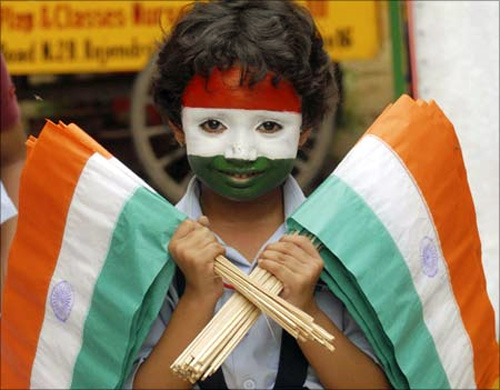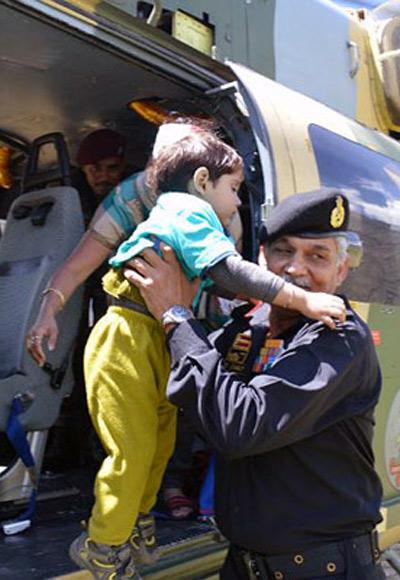Photographs: Reuters V Sridhar in Mumbai
Cannon to right of them,
Cannon to left of them,
Cannon in front of them
Volley'd and thunder'd;
Storm'd at with shot and shell,
Boldly they rode and well,
Into the jaws of Death,
Into the mouth of Hell
Rode the six hundred.
-- Lord Alfred Tennyson, The Charge of the Light Brigade
. . .
Can brands come to the rescue of the people?
Image: A Kashmiri woman walks under a garland made of rupee notes on display at a market in Srinagar.Photographs: Fayaz Kabli/Reuters
Adversity brings out the best and the worst in us.
While some turn into heroes in the face of catastrophes, others succumb to its effects.
If history has taught us anything, it is this: It repeats itself. Disasters are no strangers to our history.
While science has advanced to great levels, nature still has an upper hand.
It is the element of unpredictability that makes these calamities even more fierce and unconquerable.
While we can’t predict these, what we can do is face these with courage and might.
Brands are no different.
It is worth looking at how brands respond to such times of urgent need.
. . .
Can brands come to the rescue of the people?
Image: A Kashmiri shop owner in Srinagar.Photographs: Danish Ismail/Reuters
Like people, brands in the past have stood up bravely to grave disasters.
Havas Media explored the role of brands in times of urgent need, finding which were the most meaningful ones following the 2011 Japanese disaster.
When the disaster hit Japan on March 11, Uniqlo, the fashion retailer, donated $25.6 mn to the Japanese Red Cross to help those affected by the earthquake and tsunami in north-eastern Japan.
The brand’s founder and president of Fast Retailing, Tadashi Yanai, also donated $12.2 million.
The brand sent thousands of Uniqlo products, including jeans, coats, towels and 300,000 pairs of its Heattech thermal underwear to disaster victims.
Sony donated ¥300 mn to the Central Community Chest of Japan.
. . .
Can brands come to the rescue of the people?
Image: Customers wait to pay for their goods at a Best Price Modern Wholesale store.Photographs: Ajay Verma/Reuters
Also, the company donated 30,000 radios, 500,000 batteries and 125 televisions for emergency use in the immediate aftermath of the disaster.
Even employees of Sony were asked to come forward and contribute to the relief efforts. Sony also started a company-wide matching gift programme in which the employee’s contributions to relief agencies were matched, dollar for dollar, by the company.
One week after the start of this initiative, approximately 40,000 Sony employees from 40 countries had collectively contributed ¥200 mn to the relief efforts (courtesy Guardian).
Coming back to home, the front page of every newspaper these days has been flooded with stories of the Uttarakhand catastrophe.
Unfortunately, we have hardly seen any brands in India taking any big initiatives to help the people who have suffered.
. . .
Can brands come to the rescue of the people?
Image: An employee carries bundles of Indian currency notes inside a bank in Agartala.Photographs: Jayanta Dey/Reuters
The lack of any relief efforts from brands is conspicuous and appalling in such a scenario. When the Kumbh Mela takes place, we see a lot of brands participating but in times of needs like these, they seem to have retreated.
What does this imply?
It portrays brands in a poor light, making them look like money-minded sharks hovering around people in times of business and leave their side when they need them.
But what these brands don’t realise is that good begets good.
If brands do something good, then good will come back to them.
. . .
Can brands come to the rescue of the people?
Photographs: Courtesy: http://suryahopes.in/
Good business sense means helping each other.
If brands don’t help people when they need it, then why will people help them in return?
Why will they buy?
By helping in times of adversities, brands can become a part of their lives.
All these initiatives build good relations with people.
Whom will you sell if there’s no one around?
Today, brands expect more from people than the other way round.
Let this adversity bring out the best within us and our brands, so that they come forward with gusto to lend a helping hand to those who have given so much to them but have lost so much now.
The author is National Creative Director, Leo Burnett








article